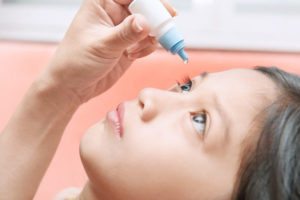August 9, 2019
By Huy Tran, MD, PhD candidate, Brien Holden Vision Institute
Summary
 Although concentration-dependent efficacy and side effects were reported with atropine and a case made for low concentration atropine, i.e., 0.01% as an effective dose with lowered side effects, the lack of an appropriate placebo group rendered the data uncertain. The LAMP study was a randomized, double-masked, placebo-controlled study that aimed to determine the efficacy of three different low-concentration atropine eye drops, 0.05%, 0.025%, and 0.01% compared to 0.9% sodium chloride over a 1-year period. The study plans to continue beyond the 1-year period to further evaluate the efficacy, long-term safety, and rebound effects.
Although concentration-dependent efficacy and side effects were reported with atropine and a case made for low concentration atropine, i.e., 0.01% as an effective dose with lowered side effects, the lack of an appropriate placebo group rendered the data uncertain. The LAMP study was a randomized, double-masked, placebo-controlled study that aimed to determine the efficacy of three different low-concentration atropine eye drops, 0.05%, 0.025%, and 0.01% compared to 0.9% sodium chloride over a 1-year period. The study plans to continue beyond the 1-year period to further evaluate the efficacy, long-term safety, and rebound effects.
In the study, 438 myopic children aged between 4 and 12 years old were randomly allocated into four groups in a 1:1:1:1 ratio to receive nightly either one in three concentrations of atropine or the placebo drops. The primary variables studied were changes in spherical equivalent and axial length over a 1-year period. There were no significant differences between groups at the baseline visit. All of the participants were followed using an identical protocol at 2 weeks, 4, 8, and 12 months.
After one year, the mean change in spherical equivalent was −0.81 ± 0.53D, −0.59 ± 0.61D, −0.46 ± 0.45D,−0.27 ± 0.61D and the change in axial length was 0.41 ± 0.22 mm, 0.36 ± 0.29 mm, 0.29 ± 0.20 mm, 0.20 ± 0.25 mm in the placebo, 0.01%, 0.025% and 0.05% atropine eye drops, respectively. Atropine at 0.05% concentration showed the best efficacy in slowing myopia, whereas the change in axial length with 0.01% was not significant. The myopia control effects of low-concentration atropine were significant and dose-dependent concerning spherical equivalent and axial length, except the group of 0.01% atropine. Changes in accommodative amplitude and pupil diameter followed a concentration-dependent response, whereas visual acuity was not significantly affected and subjective symptoms were not significant.
The study confirmed the efficacy of low-concentration atropine at dose of 0.05% and 0.025% for slowing myopia but did not find 0.01% to be effective. Although the study was double masked, reporting of symptoms by the participants and the presence of a dilated pupil would have complicated masking, but the authors indicated that investigators involved in measuring outcome measures were always masked.
ABSTRACT
Low-Concentration Atropine for Myopia Progression (LAMP) Study: A Randomized, Double-Blinded, Placebo-Controlled Trial of 0.05%, 0.025%, and 0.01% Atropine Eye Drops in Myopia Control
PURPOSE: Low-concentration atropine is an emerging therapy for myopia progression, but its efficacy and optimal concentration remain uncertain. Our study aimed to evaluate the efficacy and safety of low-concentration atropine eye drops at 0.05%, 0.025%, and 0.01% compared with placebo over a 1-year period.
DESIGN: Randomized, placebo-controlled, double-masked trial.
PARTICIPANTS: A total of 438 children aged 4 to 12 years with myopia of at least -1.0 diopter (D) and astigmatism of -2.5 D or less.
METHODS: Participants were randomly assigned in a 1:1:1:1 ratio to receive 0.05%, 0.025%, and 0.01% atropine eye drops, or placebo eye drop, respectively, once nightly to both eyes for 1 year. Cycloplegic refraction, axial length (AL), accommodation amplitude, pupil diameter, and best-corrected visual acuity were measured at baseline, 2 weeks, 4 months, 8 months, and 12 months. Visual Function Questionnaire was administered at the 1-year visit.
MAIN OUTCOME MEASURES: Changes in spherical equivalent (SE) and AL were measured, and their differences among groups were compared using generalized estimating equation.
RESULTS: After 1 year, the mean SE change was -0.27±0.61 D, -0.46±0.45 D, -0.59±0.61 D, and -0.81±0.53 D in the 0.05%, 0.025%, and 0.01% atropine groups, and placebo groups, respectively (P < 0.001), with a respective mean increase in AL of 0.20±0.25 mm, 0.29±0.20 mm, 0.36±0.29 mm, and 0.41±0.22 mm (P < 0.001). The accommodation amplitude was reduced by 1.98±2.82 D, 1.61±2.61 D, 0.26±3.04 D, and 0.32±2.91 D, respectively (P < 0.001). The pupil sizes under photopic and mesopic conditions were increased respectively by 1.03±1.02 mm and 0.58±0.63 mm in the 0.05% atropine group, 0.76±0.90 mm and 0.43±0.61 mm in the 0.025% atropine group, 0.49±0.80 mm and 0.23±0.46 mm in the 0.01% atropine group, and 0.13±1.07 mm and 0.02±0.55 mm in the placebo group (P < 0.001). Visual acuity and vision-related quality of life were not affected in each group.
CONCLUSIONS: The 0.05%, 0.025%, and 0.01% atropine eye drops reduced myopia progression along a concentration-dependent response. All concentrations were well tolerated without an adverse effect on vision-related quality of life. Of the 3 concentrations used, 0.05% atropine was most effective in controlling SE progression and AL elongation over a period of 1 year.
Yam, J. C., Jiang, Y., Tang, S. M., Law, A. K., Chan, J. J., Wong, E., … & Pang, C. P. (2019). Low-concentration Atropine for Myopia Progression (LAMP) study: a randomized, double-blinded, placebo-controlled trial of 0.05%, 0.025%, and 0.01% atropine eye drops in myopia control. Ophthalmology, 126(1), 113-124.
DOI: 10.1016/j.ophtha.2018.05.029

Huy Tran is a pediatric ophthalmologist at the Myopia Control Clinic of Hai Yen Eye Care, Ho Chi Minh City, Vietnam, and a PhD candidate at the Brien Holden Vision Institute.













